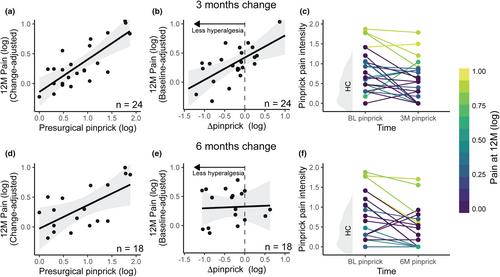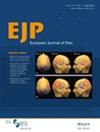Prognostic value of preoperative mechanical hyperalgesia and neuropathic pain qualities for postoperative pain after total knee replacement
Abstract
Background
Total knee replacement (TKR) is the gold standard treatment for end-stage chronic osteoarthritis pain, yet many patients report chronic postoperative pain after TKR. The search for preoperative predictors for chronic postoperative pain following TKR has been studied with inconsistent findings.
Methods
This study investigates the predictive value of quantitative sensory testing (QST) and PainDETECT for postoperative pain 3, 6 and 12 months post-TKR. We assessed preoperative and postoperative (3 and 6 months) QST measures in 77 patients with knee OA (KOA) and 41 healthy controls, along with neuropathic pain scores in patients (PainDETECT). QST parameters included pressure pain pressure threshold (PPT), pain tolerance threshold (PTT), conditioned pain modulation (CPM) and temporal summation (TS) using cuff algometry, alongside mechanical hyperalgesia and temporal summation to repeated pinprick stimulation.
Results
Compared to healthy controls, KOA patients at baseline demonstrated hyperalgesia to pinprick stimulation at the medial knee undergoing TKR, and cuff pressure at the calf. Lower cuff algometry PTT and mechanical pinprick hyperalgesia were associated with preoperative KOA pain intensity. Moreover, preoperative pinprick pain hyperalgesia explained 25% of variance in pain intensity 12 months post-TKR and preoperative neuropathic pain scores also captured 30% and 20% of the variance in postoperative pain at 6 and 12 months respectively. A decrease in mechanical pinprick hyperalgesia from before surgery to 3 months after TKR was associated with lower postoperative pain at the 12 months post-TKR follow-up.
Conclusion
Our findings suggest that preoperative pinprick hyperalgesia and neuropathic-like pain symptoms show predictive value for the development of chronic post-TKR pain.
Significance Statement
This study's findings hold significant implications for chronic pain management in knee osteoarthritis patients, particularly those undergoing total knee replacement surgery (TKR). Mechanical hyperalgesia and neuropathic pain-like characteristics predict postoperative pain 1 year after TKR, emphasizing the importance of understanding pain phenotypes in OA for selecting appropriate pain management strategies. The normalization of hyperalgesia after surgery correlates with better long-term outcomes, further highlighting the therapeutic potential of addressing abnormal pain processing mechanisms pre- and post-TKR.


 求助内容:
求助内容: 应助结果提醒方式:
应助结果提醒方式:


